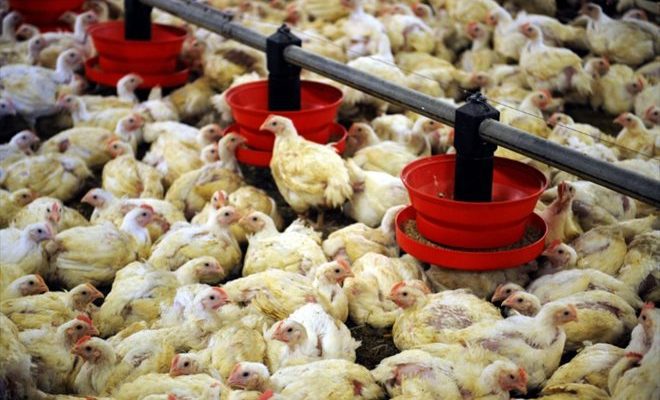Chicken consumption is increasing in France, which raises the question of sources of supply and farming conditions (AFP/Archives/Fred TANNEAU)
Chicken consumption is increasing in France, especially in fast food where new brands are springing up, which raises the question of sources of supply and farming conditions, while the European Commission must revise its legislation on welfare animal.
Last year, France became the leading consumer country of chicken in Europe ahead of Germany and Spain, with more than 28 kg consumed per person on average: this meat remains one of the cheapest, although it has not been spared by inflation (+18%, according to INSEE).
As a sign of this enthusiasm, new franchises are appearing in fast food, such as the Korean fried chicken chain Bonchon, which opened its first restaurant in Paris in March. The Napaqaro group (Buffalo Grill, Courtepaille) launched the American franchise Popeyes Louisiana Kitchen in the capital in February and is aiming for 300 establishments by 2030.
“Chicken is on the rise: it is a nutritionally interesting and low-carbon protein,” Isabelle Herman, general manager of the American giant Kentucky Fried Chicken (KFC), which has 328 restaurants in France, told AFP. and says it has “still a great potential for openings”, after having created 25 establishments last year.
To support this development, KFC has entered into a partnership with the poultry producer LDC (chickens from Loué, Le Gaulois) which has enabled it to double its supplies of tricolor chicken, to 47% of the total. The rest comes “mainly from the Netherlands and Poland”, she specifies.

KFC has entered into a partnership with the poultry producer LDC (chickens from Loué, Le Gaulois) which has enabled it to double its supplies of tricolor chicken (AFP/Archives/Karen BLEIER)
The group is proud of this effort in “a complicated economic context”, says Ms. Herman. “Our franchisees had to agree to reduce their margin, since we only included half of inflation in our consumer prices, which was 25% on our raw material costs, i.e. on average 11-12%” .
For its part, McDonald’s indicates that it sources two-thirds (18,000 tonnes per year) of its chicken needs from France, from 219 breeders, and the rest, especially from Germany and the Netherlands.
The brand is committed to ensuring that “100% of the chickens in its French sector are raised in buildings (…) equipped with natural light in an environment “promoting natural behavior”, including perching and baths. dust, she told AFP.
– Chicken density per square meter –
KFC France promises that “by 2026”, 100% of its chicken supply will come from farms and slaughterhouses respecting the criteria of the “Better Chicken Commitment”, a base of criteria defended by animal protection NGOs: less density of farms, better environment, absence of cages, less cruel slaughter…

In a sign of the chicken craze, new fast food franchises are popping up (Getty/AFP/Archives/SCOTT OLSON)
But KFC has “not committed to including a minimum part of the outdoors in its supplies”, deplores the association for the protection of farm animals Welfarm.
The latter was delighted to see the Advertising Ethics Jury, on March 13, be alarmed by an advertisement by the brand for KFC’s “Crispy Box” featuring “a chicken bouncing on its stomach of a cow (…) in a bucolic setting”, while the poultry “are raised in buildings in permanent confinement”, notes Welfarm.
This advertisement “is likely to mislead the public about the reality of the breeding conditions of the chickens used by KFC”, estimated the Jury.
But in reality, is improving chicken welfare on the way?
While the European Commission must soon revise its legislation on animal welfare, the European Food Safety Authority (EFSA) has notably recommended reducing the density of chickens on farms, estimating that a density greater than 11 kg per square meter was detrimental to them.

The European Food Safety Authority (EFSA) recommends reducing the density of chickens on farms (AFP/Archives/FRED TANNEAU)
The limit for entry-level chickens is currently 33 kg per m2 (i.e. approximately 17 chickens per m2) and up to 42 kg on derogation.
These recommendations, considered minimal by animal protection NGOs who expect a toughening of European regulations, are rejected by European agricultural organizations (Copa-Cogeca, AVEC…), which warn of a risk of “disappearance of the major part of the European poultry sector, meat and eggs combined”, in a context of fierce competition between producer countries.
Because according to French poultry professionals gathered in Anvol, the sector is “overwhelmed by imports”: half of the chicken consumed in France – which has 14,000 farms – is now imported, against a quarter in 2000.
© 2023 AFP
Did you like this article ? Share it with your friends with the buttons below.




